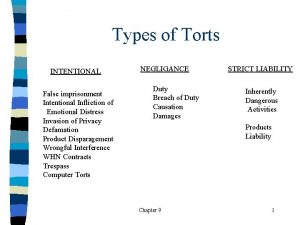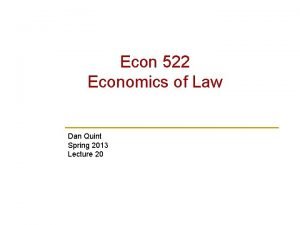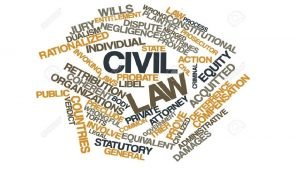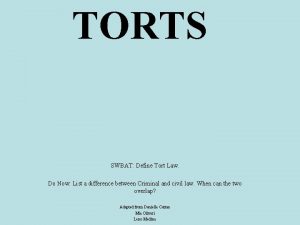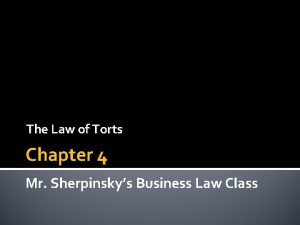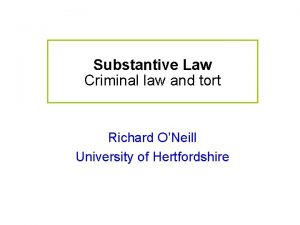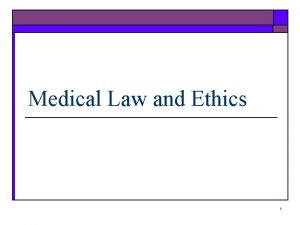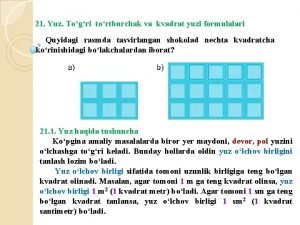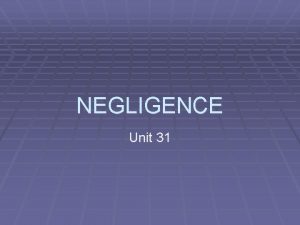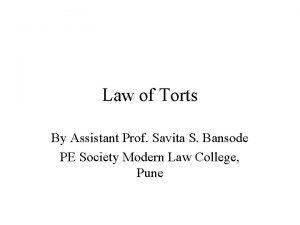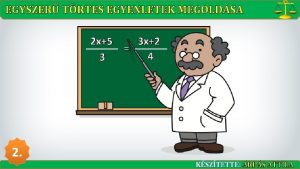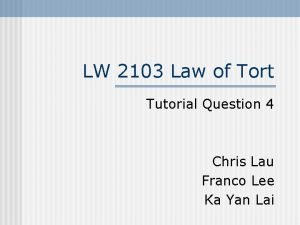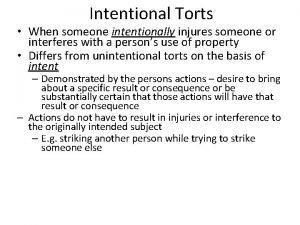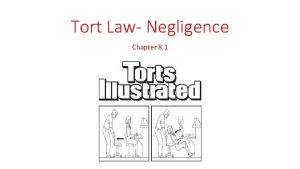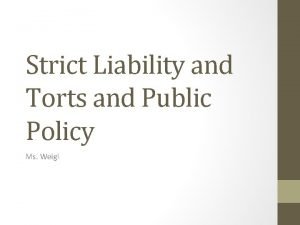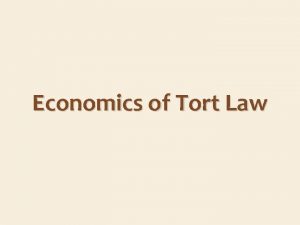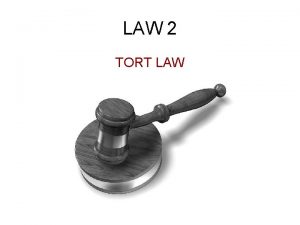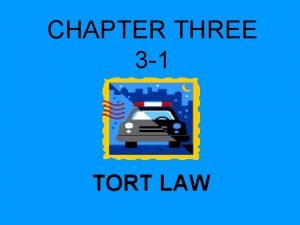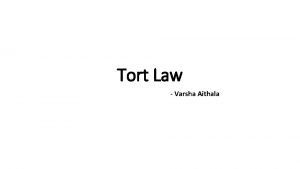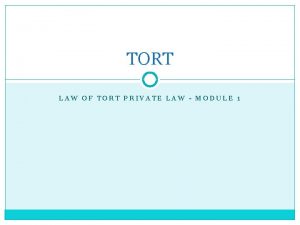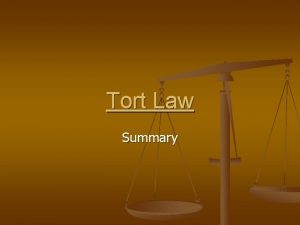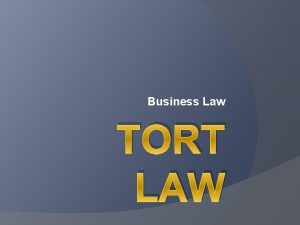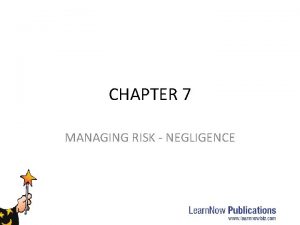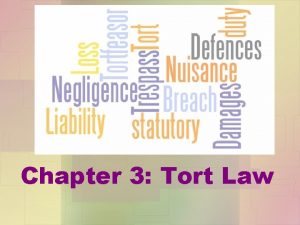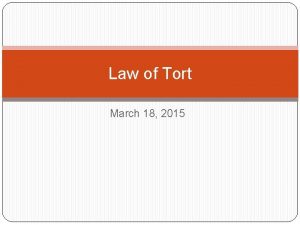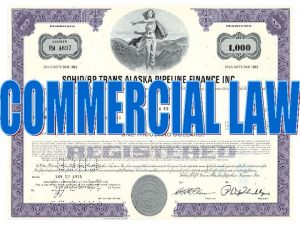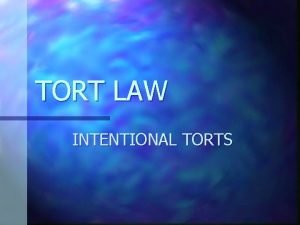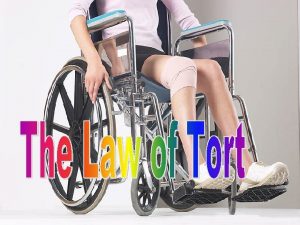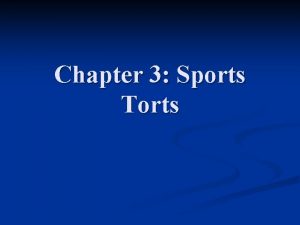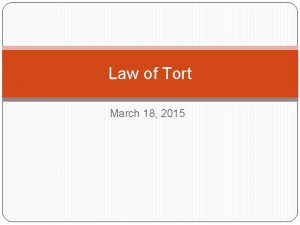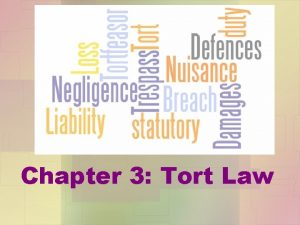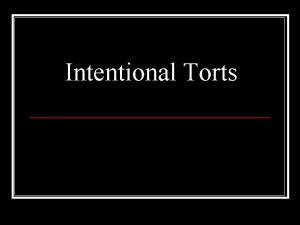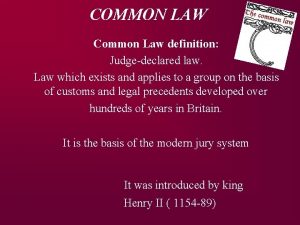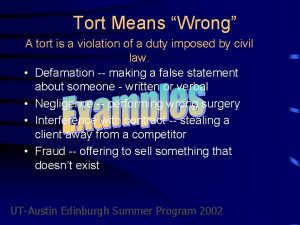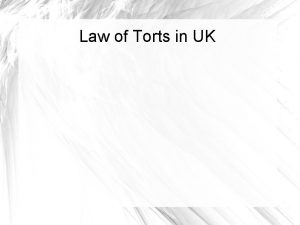LAW OF TORT DEFINITION A tort is a


























- Slides: 26

LAW OF TORT

DEFINITION A tort is a civil wrong of which a person who sustains injury or damages can institute civil proceedings against the person who commits the tortious act. Liability in tort arises when a person does something that is not allowed, or does not do something that is required, by the law. Plaintiff – a person who suffers injury Tortfeasor / defendant – A person who commits or responsible for the injury.

Plaintiff need to prove that he suffered damage or harm before the defendant is held liable. Damage may be in the form of: ü physical injuries, ü damage to reputation or ü economic loss. A person who suffers injury is entitled to sue for damages. Damages means the monetary compensation that the defendant is ordered to pay to the plaintiff. Damages fall into 2 broad categories. ü Liquidated damages refers to specific damage that the plaintiff has suffered, for instance loss of earnings and medical bills. ü Unliquidated damages refers to unjustifiable damage which includes general damages for pain and

SOURCES OF LAW OF TORT IN MALAYSIA Common Law Legislation ( Defamation Act 1957)

LAW OF TORT NEGLIGENCE TRESPASS ü PERSON, ü LAND ü GOODS NUISANCE DEFAMATION STRICT LIABILITY VICARIOUS LIABILITY OCCUPIER’S LIABILITY

1. NEGLIGENCE

DEFINITION Negligence can be defined as a breach of legal duty to take care which results in damage to the claimant. Negligence is established when four elements are fulfilled. 1. A legal duty to exercise care to the claimant 2. There was a breach of such duty 3. Damage/Injury was caused as a result of the breach 4. The damage suffered was not too remote

Elements : (1) A legal duty to exercise care to the claimant A person will only be liable in negligence if he is under a legal duty to take care. There a number of situations in which the courts recognise the existence of a duty of care. These usually results of some sort of special relationship between the parties. Examples include: ü one road user to another ü employer to employee ü manufacturer to consumer ü doctor to patient ü solicitor to client

The test used in determining the existence of duty of care owned to the plaintiff is the: ‘NEIGHBOUR PRINCIPLE’ (Donoghue v Stevenson) The neighbour principle was laid down in the landmark case of Donoughue v Stevenson (1932) AC 562.

Donoghue v stevenson ü ü ü FACT: A ginger-beer manufacturer, had sold ginger-beer to a retailer. The ginger-beer bottles were opaque. Mrs Donoughue’s friend bought her a bottle for entertainment, and she drank the ginger-beer. It was alleged that when her friend re-filled the glass, along with the ginger-beer came the decomposed remains of a snail. Mrs Donoughue suffered shock and was severely ill as a consequence. Mrs Donoughue sued the manufacturer, and claimed that the manufacturer had a duty in the course of his business, to prevent snails from entering into his ginger -beer bottles and further that he had a duty to ensure that all empty bottles were carefully inspected before

Donoghue v stevenson ISSUE : whether the defendant owed such a duty to the plaintiff, Mrs Donoughue. HELD: Df is liable. Although there was no contractual duty on the part of the manufacturer towards consumer (A’s friend), the manufacturer owed her a duty to take care that the bottle did not contain noxious matter and he would be liable if that duty was broken.

The test: Would a reasonable man, who is in the same circumstances as the defendant, foresee that his conduct will adversely affect the pf? If the answer is “no” – the pf is not a neighbour of the df and has no duty of care to df. If the answer is “yes” – the pf is a neighbour of the df and he owes a duty of care to df.

Elements : (2) Breach of duty FACT: ü A ginger-beer manufacturer, had sold ginger-beer to a retailer. The ginger-beer bottles were opaque. ü Mrs Donoughue’s friend bought her a bottle for entertainment, and she drank the ginger-beer. ü It was alleged that when her friend re-filled the glass, along with the ginger-beer came the decomposed remains of a snail. ü Mrs Donoughue suffered shock and was severely ill as a consequence. ü Mrs Donoughue sued the manufacturer, and claimed that the manufacturer had a duty in the course of his business, to prevent snails from entering into his ginger -beer bottles and further that he had a duty to ensure that all empty bottles were carefully inspected before

ELEMENTS: (3) Damage/Injury was caused as a result of the breach The plaintiff needs to prove that damage was caused by the defendant’s breach of duty. The question that arisen is whether the defendant’s conduct has in fact caused the damage suffered by the plaintiff. A defendant will only be liable if it is reasonably foreseeable that his conduct/action will result in some damage to the plaintiff.

ELEMENTS: (4) The damage suffered was not too remote A df will only be liable if it is reasonably foreseeable that his conduct will result in some damage to the pf. No specific guidelines may be given and the final decision is ultimately in the hands of the individual judge who may consider moral, economic and social factors.

2. TRESPASS

TRESPASS Trespass is a direct and intentional interference with the person or property or goods. Ø Trespass to person; Ø Trespass to land; and Ø Trespass to goods.

Trespass to person; 1. ASSAULT: A person commits an assault if there is an intentional act by the defendant and the plaintiff reasonable believes they are in imminent danger of harmful or offensive contact. (act which causes a reasonable man to be in fear of attack. ) 2. BATTERY: A person commits a battery when a defendant intentionally or negligently does an act which brings about an immediate or direct harmful or offensive contact to the plaintiff. 3. FALSE IMPRISONMENT: This is a situations in which the claimant or plaintiff’s movement is constrained whether this is by arrest, detention or confinement.

Trespass to land is when a person directly and voluntarily interfere with another person’s lawful possession of land Trespass to land has 4 elements: 1. There must be direct interference with the land; 2. The interference must be voluntary; 3. The defendant need not be aware that they are trespassing; and 4. There is no requirement for harm or damage.

TRESPASS TO GOODS Conversion A wrong committed by dealing with the goods of a person which constitutes an unjustifiable denial of his rights in them. It involves interference with the property of another, and with the intention of exercising control over it. The defendant’s act must be voluntary and therefore done deliberately and intentionally. Conversion may be committed by wrongfully – Ø Taking possession of the goods; Ø Disposing of them; Ø Destroying them; or Ø Refusing to give them up when asked to.

✣Detinue is the wrongful detention of goods which the plaintiff has an immediate right to possess. Detinue often arises in situations where the df initially has posession over the goods but subsequently refuses to return them to the rightful owner without any reasonable excuse.

3. VICARIOUS LIABILITY

VICARIOUS LIABILITY Situation for vicarious liability: A is liable to C for damage suffered by C due to the negligence or other tort committed by B tortious act relationship liable Vicarious liability arises where a particular relationship exists between the parties; such as employer-employee relationship the principal agent relationship.

In respect of relationship between employer and employee, vicarious liability generally only applies to the acts of employees committed in the course of their employment. An employer is only liable for torts committed by his employees and not those committed by an independent contractor. So the distinction between these two is important.

VICARIOUS LIABILITY The control test (OLD TEST) The control test distinguishes an employee and an independent contractor on the basis of whether the employer had the right to control the nature of the work done and how it must be done. The organisation or integration test: The organisation test makes a distinction between a contract of service & a contract for service.

CONTRACT OF SERVICE The person works as part of the organization. His work forms an integral part of that organization E. g. captain of ship, a driver, a lecturer CONTRACT FOR SERVICE Eventhough the work is done for the organization, it is not integrated into it but is only accessory to it. E. g. a ship’s pilot, a taxi driver, a cleaner in university.
 Essentials of tort
Essentials of tort Types of tort law
Types of tort law Dr alexander degazon
Dr alexander degazon Tort in law
Tort in law Tort in law
Tort in law Example of tort
Example of tort Newton's first law and second law and third law
Newton's first law and second law and third law Newton's first law
Newton's first law Boyle's law charles law avogadro's law
Boyle's law charles law avogadro's law P=k/v
P=k/v Unintentional tort examples
Unintentional tort examples Tort richard
Tort richard Tort examples in healthcare
Tort examples in healthcare Federal torts claim act coverage
Federal torts claim act coverage Toʻgʻri toʻrtburchak
Toʻgʻri toʻrtburchak Tort titanic
Tort titanic Tort and contract difference
Tort and contract difference Chesmore vs richards
Chesmore vs richards Törtes egyenlet megoldása
Törtes egyenlet megoldása Hogyan szorzok törtet egész számmal
Hogyan szorzok törtet egész számmal Tort healthcare
Tort healthcare Tort lw
Tort lw Intentional tort
Intentional tort Elements of tort
Elements of tort Strict liability offence
Strict liability offence Strict liability
Strict liability Pas bien dans sa vie michele torr
Pas bien dans sa vie michele torr

